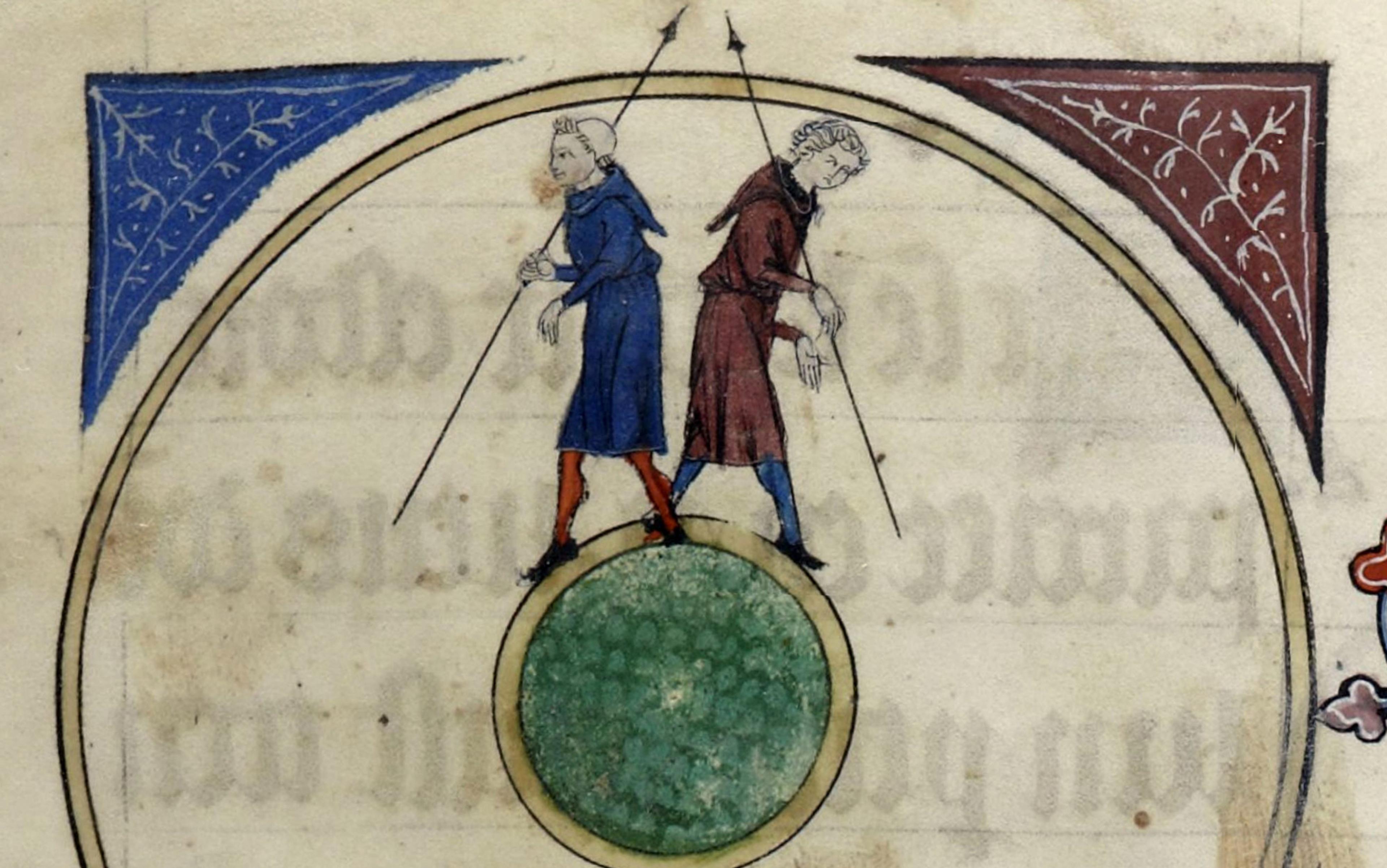Listen to this essay
Since the earliest days of science, dissent and disagreement have driven its progress. Galileo’s defiance of the geocentric consensus was invaluable for science’s advance. Albert Einstein and Niels Bohr’s disagreements over the interpretation of quantum mechanics generated many fruitful insights. Yet not all disagreement is scientifically valuable. Science denialism – the rejection of well-established claims – is currently on the rise. A vaccine sceptic heads the United States Department of Health and Human Services. Several climate change deniers have been appointed to prominent scientific positions within the US government. And many important scientific projects concerning the prevention of infectious diseases, cancer treatments and climate change have been defunded for political reasons. All of this raises pressing questions: when is disagreement with scientific consensus valuable? When is it problematic? And how should we respond to it?

Charles Darwin (l) disagreed with Lord Kelvin’s (r) estimation of the age of Earth. Illustration montage by Aeon
Let’s start with a striking example from the history of science. In 1863, William Thomson, also known as Lord Kelvin, claimed that Earth’s age was only around 100 million years. The estimate was rooted in the second law of thermodynamics, and Kelvin – known for his discovery of absolute zero – was a titan in all things thermodynamical. But this estimate posed a significant challenge to a new theory that had recently entered the scene. If natural selection were to explain the biological diversity and complexity that served as one of Charles Darwin’s main lines of evidence in On the Origin of Species (1859), then Earth needed to be at least 100 million years older than Kelvin’s estimates. Reflecting on this, Darwin wrote:
With respect to the lapse of time not having been sufficient since our planet was consolidated for the assumed amount of organic change, and this objection, as urged by Sir William Thompson [sic] is probably one of the gravest as yet advanced, I can only say, firstly that we do not know at what rate species change as measured in years, and secondly that many philosophers are not yet willing to admit that we know enough of the constitution of the Universe and of the interior of our globe to speculate with safety on its past duration.
Darwin’s words of caution about the constitution of the Universe and planet were prescient. In hindsight, we can say that Kelvin misunderstood how Earth cooled. Yet the responses to Kelvin’s misunderstandings advanced several sciences in myriad ways. First, physicists (including Kelvin himself) tested a wide range of hypotheses regarding the heat and age of Earth. These theoretical excursions ultimately uncovered flaws in Kelvin’s assumptions about Earth’s rigidity and homogeneity. Second, physicists, geologists and palaeontologists began developing novel methods for using radioactive decay and half-life to date the planet, which in turn produced new and powerful forms of evidence. These methods also revealed flaws in Kelvin’s assumptions about heat within Earth and from the Sun. Finally, some evolutionary theorists (including Darwin) responded to Kelvin’s challenge by exploring different mechanisms for expediting evolutionary change such as sexual selection.
The responses to Kelvin’s ideas illustrate that scientific communities are often adroit at improving understanding by correcting misunderstandings. It would seem that, at certain points in scientific research, it’s even been good that scientists have misunderstood, since this ultimately sparked understanding in their peers that eclipsed the initial misunderstanding. To see the point another way, had Kelvin accurately estimated Earth’s age, then the responses to his work would have been less likely to generate the insights that they did over the same stretch of time.
These ‘valuable misunderstandings’, as we call them, highlight several interesting aspects of science. They’re valuable not because of their originators, who may be mired in confusion, shackled by stubbornness or sullied by shoddy motives. Rather, it’s other scientists’ uptake and transformation of these misunderstandings that gives them their value. Because of this, valuable misunderstandings provide fresh insights as to what’s wrong with science denialism, why scientific consensus isn’t always desirable, the dangers of defunding science, and how science should be communicated. They also call on scientists to exercise intellectual humility in the context of disagreement – both with each other and with the broader public.
Before exploring these issues, we need to get clearer on what it means to misunderstand, to improve understanding, and to correct a misunderstanding. Standing at the crossroads of these ideas is the concept of understanding, which has garnered significant philosophical attention in the past few decades.
Consider the understanding we have of the occurrence of a fire. A paradigmatic way of understanding why there is a fire is to correctly explain the fire’s occurrence – for example, because someone struck a match. However, understanding improves not only by explaining what actually caused the fire, but also by explaining what could have caused the fire. A person who recognises not only that a fire was caused by a match, but that it also could have been caused by embers, lightning or chemical compounds has a deeper understanding of the fire than the person who can identify only the struck match as the actual cause of the fire. The intuitive idea is that, if having the correct explanation of a phenomenon provides understanding, then grasping additional possible explanations of that phenomenon provides a deeper understanding.
If the preceding is right, then understanding consists in identifying both the actual and the possible factors that explain a phenomenon. So construed, it should be clear that science aims to understand. After all, scientists are not content to merely enumerate a list of facts – they also seek to uncover why and how those facts unfold, operate and interact.
Improvements in understanding are produced by correcting a misunderstanding
With our rough-and-ready account of understanding in hand, we can begin to flesh out our conception of valuable misunderstandings. Misunderstanding involves mistaken explanations. In Kelvin’s case, he misunderstood Earth’s age not only because of his sizeable underestimation, but also because he mistook various relationships between Earth’s age, rigidity and uniformity. That is, Kelvin misunderstood because he endorsed incorrect explanations of the age of Earth.
This account of understanding also highlights two ways that we can improve our understanding. First, understanding improves when we discover new explanatory connections. In responding to Kelvin’s misunderstanding, new links between evolution, geology and radioactive decay were unearthed. Second, understanding improves when we can distinguish which explanations are actual and which are only possible. An obvious upshot of the response to Kelvin’s misunderstanding is that scientists learned that it was only possible for Earth to be as new as Kelvin asserted, while it was actually much older.
In valuable misunderstandings, these improvements in understanding are produced by correcting a misunderstanding. These corrective processes have several characteristic features. First, the person doing the correcting doesn’t perpetuate the misunderstanding. Second, the correction isn’t fluky: the person doing the correcting has the aim of transforming a misunderstanding into something that improves understanding. Third, this process has to consist of reasoning and methods that reliably transform misunderstandings into understandings. Fourth, the process is frequently open-ended enough that future investigations might reveal additional misunderstandings (including what is currently taken to be understood) that require correction.
Science is laudable for having assembled an impressive stockpile of corrective processes meeting these criteria: treating something as a hypothesis and drawing out its implications; developing methods that more carefully ferret out misunderstandings; constructing new models that suggest alternative explanations to challenge a misunderstanding; and so on. Corrective processes that reliably turn misunderstandings into understanding are thus a hallmark of science.
Valuable misunderstandings should be distinguished from other cases in which a misunderstanding is part of a causal chain that ends with improved scientific understanding. Consider the curious case of Roger Babson, a 20th-century entrepreneur and economist who made a fortune applying Isaac Newton’s laws to the stock market. Babson had a strange fascination with gravity. He hated it and blamed it for the tragic drowning of his younger sister as a child. In fact, in his autobiography, he blamed gravity for a multitude of human problems:
Gravity may be called Enemy Number One for those over 60 years of age. It is even being thought that there is a correlation between accidents and disease and the different phases of the Moon, which, if so, means that our chances of getting hurt varies with changes in the gravity pull on our bodies.
Driven by this misunderstanding of gravity, Babson founded the Gravity Research Foundation (GRF) in 1949. In exchange for the GRF’s funds for researching gravity, colleges and universities had to erect concrete slabs on their campuses that read:
This monument has been erected … by the Gravity Research Foundation … it is to remind students of the blessings forthcoming when science determines what gravity is, how it works, and how it may be controlled.
The foundation recently celebrated its 75th anniversary and is still awarding researchers for working on understanding gravity and its effects. Much of this work has improved the scientific community’s understanding of foundational constants of the Universe, planetary motion and the stock market.
Kelvin’s understanding of Earth’s age did not improve by considering the corrective responses to his work
Despite Babson’s misunderstanding of gravity playing a role in bringing about these scientific advances, this does not count as a valuable misunderstanding. Recipients of these grants did not have to correct his misunderstanding. They were free to ignore his exotic ideas about gravity’s maleficence when carrying out their research. Ignoring is not an option with valuable misunderstandings. While misunderstanding is a necessary part of corrective processes, it is not sufficient for that misunderstanding to be valuable in our sense.
Having a better sense of what valuable misunderstandings are – and also what they are not – it’s worth acknowledging other philosophers who have discussed these issues. The 19th-century polymath John Stuart Mill already appreciated the importance of valuable misunderstandings. As he wrote in his classic On Liberty (1859):
… on every subject on which difference of opinion is possible, the truth depends on a balance to be struck between two sets of conflicting reasons. Even in natural philosophy [ie, science], there is always some other explanation possible of the same facts; … and it has to be shown why that other theory cannot be the true one: and until this is shown, and until we know how it is shown, we do not understand the grounds of our opinion.
Mill explicitly ties understanding to the capacity to adjudicate between alternative explanations and theories. This, of course, is a hallmark of valuable misunderstandings. Indeed, a rather striking feature of Mill’s work is that he does not limit valuable misunderstandings’ importance to science:
… when we turn to subjects infinitely more complicated, to morals, religion, politics, social relations, and the business of life, three-fourths of the arguments for every disputed opinion consist in dispelling the appearances which favour some opinion different from it.
While we are admirers of Mill, he is mostly focused on cases in which a single individual comes to better understand their position by identifying reasons to favour it over alternatives propounded by others. The Kelvin case doesn’t work this way. Kelvin’s understanding of Earth’s age did not seem to improve by considering the corrective responses to his work. Furthermore, since Earth’s age, natural selection and radioactive decay are very different phenomena, they are not naturally glossed as ‘alternatives’ to each other. This suggests that Mill’s picture underestimates the richness and versatility of corrective processes.
Feminist philosophers of science have also anticipated several important aspects of valuable misunderstandings. Helen Longino’s masterful Science as Social Knowledge (1990) contends that scientific communities should be organised to foster transformative criticism. Longino’s transformative criticisms involve not only the raising of critiques, but various social processes for ensuring uptake of those criticisms, such that scientific claims confronting critical scrutiny are revised. Longino’s work is insightful partly because transformative criticism is not only of the utmost importance in unearthing sexist biases in science – a central objective of Longino’s project – but also because transformative criticism is important to science writ large. Because our corrective processes are both transformative and critical of misunderstandings, they are proud descendants of Longino’s ideas.
That said, there are some important differences. Longino sees transformative criticism as a defining characteristic of objectivity, but not necessarily of understanding. Yet scientific claims that are merely descriptive or predictive may be objective without providing much understanding of why something occurred. For example, as a result of critical discussion with my peers, I may have objectively good reasons to predict that the chemical in my lab experiment will turn blue. However, the objectivity (and accuracy) of this prediction is importantly different from understanding why the chemical turns blue. Additionally, Longino’s view centres on scrutinising values and background assumptions from multiple perspectives. Because valuable misunderstandings involve correcting mistaken explanations, they aim to criticise and transform rather different things.
Despite these differences, we agree with Mill and Longino that being able to respond to a diversity of opinions is a crucial component of well-functioning intellectual communities. Indeed, we propose that a scientific community’s ‘health’ should be measured in terms of its capacity to foster valuable misunderstandings. This helps to better diagnose – and ideally remedy – the threats that science currently faces.
The chief sin of science deniers is clinging to a misunderstanding that is no longer valuable
Those who worry about a ‘war on science’ frequently point to badly behaving individuals or groups who contradict a scientific consensus for some nefarious or irrational purpose such as pseudoscientific critics of climate change, natural selection and vaccines. If a scientific community’s power to nurture valuable misunderstandings is a yardstick of its vibrancy, then these science deniers are problematic because they perpetuate misunderstandings that are no longer valuable. This typically occurs when there have been extensive and adequate corrective responses to misunderstandings. In other words, if scientists have already expanded their theoretical, methodological and empirical apparatuses to correct a misunderstanding – and, in the process, have already taken that misunderstanding as a serious possibility – then holding fast to that misunderstanding is pernicious.
To appreciate this point, consider the scientific community’s response to vaccine scepticism. The fountainhead of misinformation is a (now-retracted) paper purporting to establish a vaccine-autism link. Long before this study, scientists responded to concerns about vaccines’ safety by testing several hypotheses relating to their interactions with the immune system. Thus, some of the public’s misunderstanding of vaccines had already begun to be transformed into understanding even before the publication of this study. Immediately following the paper’s publication in 1998, numerous studies were conducted that tested various hypotheses that either linked vaccines and autism or claimed that too many vaccines could ‘overwhelm’ the immune system. These studies resulted in the rejection of these hypotheses and the generation of several alternative hypotheses that could be subject to future testing. As a result, the scientific community’s corrections of these misunderstandings have advanced scientific understanding. In short, for a time, the hypothesis that vaccines cause autism was a valuable misunderstanding. Given that much of this work was done because of public concerns about vaccine safety, this example nicely illustrates how corrective processes can be effectively employed regardless of whether the misunderstanding comes from inside or outside the scientific community.
Science deniers, however, undermine the integrity of science when they fail to recognise the expiration date on valuable misunderstandings. Once the hard work of generating alternative hypotheses, collecting data and testing various ideas has been done, we might ask whether repeatedly responding to the same dissent or misunderstanding is valuable. This is an especially pressing question given the recent resurgence in vaccine scepticism and suggestions by Robert F Kennedy Jr, the US secretary of health and human services, that additional testing on the safety of vaccines is necessary.
There are parallels with our earlier example. As a result of various responses to Kelvin’s hypotheses, Earth’s age would later be established to be much older than the length of time required for evolution to occur. Despite these effective responses, Kelvin refused to give up his dissent. Once the value had been wrung from his misunderstanding by other scientists’ corrective processes, it didn’t make sense for him to hold on to his position. Similarly, while initial responses to the public misunderstanding of vaccines have borne many scientific advances, much of the value of responding to those original lines of dissent has been exhausted and further testing is unlikely to produce new understanding.
So, on our view, the chief sin of science deniers is clinging to a misunderstanding that is no longer valuable. This contrasts with other reasons given for the ills of science denial, many of which are deftly discussed in The Fight Against Doubt: How to Bridge the Gap Between Scientists and the Public (2018) by Inmaculada de Melo-Martín and Kristen Intemann. The authors highlight the difficulties in identifying pernicious departures from a well-established scientific consensus – what they call ‘normatively inappropriate dissent’. In passing, de Melo-Martín and Intemann criticise this approach for placing too high a premium on scientific consensus. By contrast, valuable misunderstandings remind us to avoid fetishising consensus and to recall that effectively responding to dissent and criticism is a longstanding staple of scientific practice. Indeed, communities brimming with valuable misunderstandings but bereft of consensus develop several lines of research that critically engage each other. By contrast, a consensus that abhors valuable misunderstandings can be the result of groupthink, laziness or resistance to alternative viewpoints.
There are further problems with a narrow focus on scientific consensus. Much scientific knowledge falls short of widespread scientific consensus, so searching for a stable consensus among all (or most) scientists is often unable to provide reasons for trusting scientific claims. Relatedly, overemphasising consensus makes it very difficult for scientific communities to update their beliefs over time without undermining public trust. Finally, if consensus is seen as the end-state of science, then dissent is undervalued; it cannot help us correct errors or update our views over time. By treating consensus as peripheral to the problem of science denial, valuable misunderstandings sidestep these problems.
Of course, we don’t mean to suggest that consensus is worthless. When scientific consensus is trustworthy, it’s achieved by scientific communities with robust mechanisms for cultivating valuable misunderstandings – communities that effectively respond to dissent, disagreement, counterevidence and alternative explanations in ways that yield insight.
Focusing on normatively inappropriate dissent not only inflates the value of consensus, it also runs the risk of distracting from the most pernicious aspects of science denialism. First and foremost, denial of a scientific consensus is not a sin unto itself. If it were, Galileo, Newton and other scientific visionaries would end up in the same camp as climate sceptics, creationists and anti-vaxxers. Nor does it much matter that science deniers sometimes have bad motives. Andrew Wakefield, the lead author on that paper erroneously linking vaccines to autism, was allegedly paid by a solicitor (through a complicated legal manoeuvre) seeking to sue vaccine manufacturers prior to conducting his research. But his paper still yielded a valuable misunderstanding. Fortunately, while we frequently don’t know what’s driving a scientist or a science denier, their motives are irrelevant for producing valuable misunderstandings. What matters is how other scientists respond to that misunderstanding.
Focusing only on the problems with Wakefield’s original study or everyday people resisting the current consensus concerning vaccine safety blinds both scientists and the public to the corrective processes that are capable of transforming misunderstanding and dissent into new knowledge. This isn’t to say valuable misunderstandings valorise disagreements come what may. On our view, it’s not enough to simply disagree with someone who misunderstands. Valuable misunderstandings require communities to build new models, devise new methods, seek novel data and so on as corrections to misunderstandings; mere disagreement does not require these corrections.
Replying to objections is central to non-experts’ ability to determine whether to trust scientific experts
So the fixation on consensus and dissent has framed the discussions of public trust in science in unproductive ways. The general problem is that consensus is neither necessary nor sufficient for doing good science. Ditto for dissent. What both consensus and dissent miss are the corrective processes that convert misunderstanding into understanding. These processes are how science transforms disagreements and misunderstandings into the more rationally grounded beliefs that thinkers like Mill and Longino correctly valorise.
All of this suggests a very different way of communicating to the public why science deniers are mistaken: it’s because the scientific community has taken their central ideas seriously in the past but ultimately found them to bear no further fruit. It also suggests different ways of communicating why the public should trust the results of scientific enquiry: it is (at least partially) grounded in science’s ability to consistently transform misunderstanding into understanding.
Valuable misunderstandings underscore how important the scientific community’s responses to misunderstanding, dissent and disagreement are to the healthy functioning of science. As a result, scientific communities must encourage, support and educate themselves on how to effectively respond to misunderstanding. Moreover, they must do so with epistemic humility, and this applies regardless of which side of a valuable misunderstanding scientists find themselves on. Like Kelvin, they might be misunderstanding things, and should be receptive to the corrections happening around them. Alternatively, when they take someone to misunderstand, they should be more like Kelvin’s critics, open-minded and resourceful enough to discover something more fruitful from that misunderstanding. This must also be done with care, as valuable misunderstandings enable scientific communities to effectively respond to the public – even if their concerns are grounded in bad faith, ideology or misunderstandings of scientific results. This matters because satisfactorily replying to objections is central to non-experts’ ability to determine whether to trust scientific experts. In short, having processes that effectively respond to misunderstanding is not only essential to the scientific process, but also crucial for building public trust in science.
Moreover, scientists are not alone in making valuable misunderstandings a staple of the public’s perception of how science works. Politicians also play a central role. Given that scientific institutions are where these corrective processes primarily take place, defunding science – such as Kennedy’s announcement this August that the US Department of Health and Human Services is cancelling nearly $500 million from studies of mRNA vaccines – is a far graver threat than denying science. Defunding scientific institutions directly undermines science’s mechanisms for transforming dissent and misunderstanding into new understanding, evidence and truth. As long as these and other corrective processes are in place, denials can be handled – if not transformed into valuable misunderstandings.
Nor are politicians and scientists alone. Educators and journalists have a role to play by telling people not only what scientists understand or merely that there exists disagreement on some topic. That lends itself to a kind of consensus-driven narrative that papers over the hard work of handling disagreement, alternative viewpoints and misunderstandings in fruitful ways. Instead, the public needs to know how scientists came to understand by grappling with disagreements and misunderstandings. This signals to those who disagree that their viewpoints have been adequately responded to and that scientific results are not the result of ideology or laziness but of science’s capacity to transform misunderstanding into understanding.






